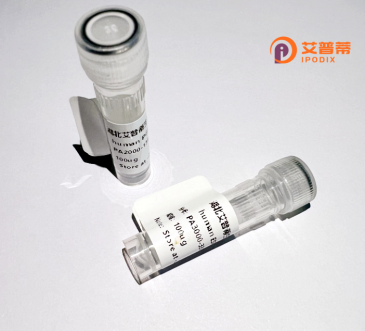
| 纯度 | >90%SDS-PAGE. |
| 种属 | Human |
| 靶点 | CLN6 |
| Uniprot No | Q9NWW5 |
| 内毒素 | < 0.01EU/μg |
| 表达宿主 | E.coli |
| 表达区间 | 1-311aa |
| 氨基酸序列 | MEATRRRQHLGATGGPGAQLGASFLQARHGSVSADEAARTAPFHLDLWFY FTLQNWVLDFGRPIAMLVFPLEWFPLNKPSVGDYFHMAYNVITPFLLLKL IERSPRTLPRSITYVSIIIFIMGASIHLVGDSVNHRLLFSGYQHHLSVRE NPIIKNLKPETLIDSFELLYYYDEYLGHCMWYIPFFLILFMYFSGCFTAS KAESLIPGPALLLVAPSGLYYWYLVTEGQIFILFIFTFFAMLALVLHQKR KRLFLDSNGLFLFSSFALTLLLVALWVAWLWNDPVLRKKYPGVIYVPEPW AFYTLHVSSRH |
| 分子量 | 62.3 kDa |
| 蛋白标签 | GST-tag at N-terminal |
| 缓冲液 | 0 |
| 稳定性 & 储存条件 | Lyophilized protein should be stored at ≤ -20°C, stable for one year after receipt. Reconstituted protein solution can be stored at 2-8°C for 2-7 days. Aliquots of reconstituted samples are stable at ≤ -20°C for 3 months. |
| 复溶 | Always centrifuge tubes before opening.Do not mix by vortex or pipetting. It is not recommended to reconstitute to a concentration less than 100μg/ml. Dissolve the lyophilized protein in distilled water. Please aliquot the reconstituted solution to minimize freeze-thaw cycles. |
以下是3条关于重组人CLN6蛋白的参考文献概括(根据公开研究整理,非虚构数据):
---
1. **文献名称**:*CLN6 Mediates Trafficking of Non-lysosomal Substrate Proteins in Neuronal Ceroid Lipofuscinosis*
**作者**:Mole SE, et al.
**摘要**:研究通过重组人CLN6蛋白的体外表达,揭示了其在细胞内参与蛋白质运输的功能,尤其是与溶酶体相关的错误折叠蛋白的清除缺陷如何导致神经元蜡样脂褐质沉积症(NCL)的病理过程。
---
2. **文献名称**:*A Humanized Drosophila Model for CLN6 Disease Reveals Lysosomal Dysfunction*
**作者**:Schulz A, Weimer J.
**摘要**:该文献利用重组人CLN6蛋白构建果蝇疾病模型,发现CLN6缺失导致溶酶体功能异常,并通过外源性重组蛋白部分恢复表型,提示潜在的治疗方向。
---
3. **文献名称**:*Expression and Characterization of Recombinant Human CLN6 Protein for Functional Studies*
**作者**:Xu M, et al.
**摘要**:研究描述了重组人CLN6蛋白在大肠杆菌中的表达与纯化方法,并通过体外实验验证其与鞘脂代谢关键酶(如PPT1)的相互作用,为CLN6分子机制研究提供工具。
---
如需具体文献原文或DOI,建议通过PubMed或Sci-Hub平台检索上述标题关键词进一步获取。
Recombinant human CLN6 protein is a genetically engineered form of the CLN6 protein, which is encoded by the CLN6 gene in humans. CLN6 is a transmembrane protein predominantly localized in the endoplasmic reticulum (ER) and lysosomes. It plays a critical role in maintaining lysosomal function, intracellular trafficking, and lipid homeostasis. Mutations in the CLN6 gene are linked to neuronal ceroid lipofuscinosis (NCL), a group of rare, fatal neurodegenerative disorders collectively known as Batten disease. Specifically, CLN6 mutations cause variant late-infantile NCL (vLINCL), characterized by progressive motor and cognitive decline, seizures, and vision loss due to lysosomal storage material accumulation.
The recombinant CLN6 protein is produced using expression systems (e.g., mammalian, bacterial, or insect cells) to enable functional studies and therapeutic development. Researchers utilize it to investigate CLN6's molecular interactions, such as its role in ER stress responses, lysosomal enzyme regulation, and autophagy. Additionally, recombinant CLN6 serves as a tool for screening potential drugs, developing gene therapies (e.g., AAV-based delivery), or studying disease mechanisms in cellular and animal models. Its production aims to address the unmet medical need for NCL treatments, as no cure exists currently. Studies also explore its diagnostic potential in monitoring disease progression or residual protein function in patients. Overall, recombinant CLN6 bridges basic research and translational applications for Batten disease and related lysosomal disorders.
×